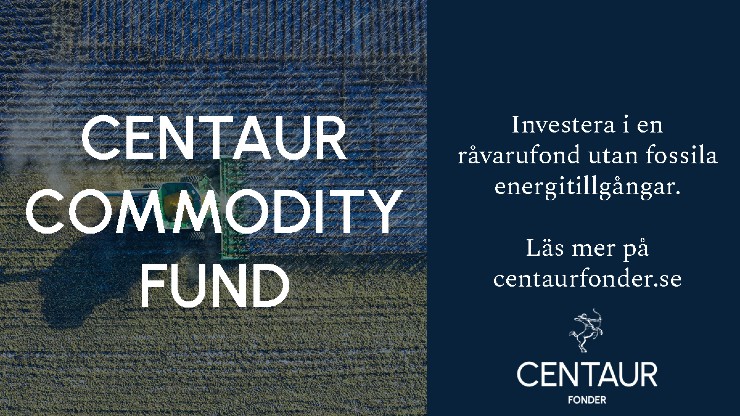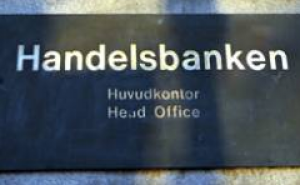Analys
SHB Råvarubrevet 28 februari 2014

![]() Veckan som gick var ovanligt tunn på makronyheter men vi laddar inför nästa veckas inköpschefsindex och payrolls. Väldigt viktig data då Kinas inköpschefer har surnat till under fyra månader i rad och USA:s dito gav en riktigt låg siffra förra månaden. Investerare som har överviktat råvaror under detta år har haft en bra utveckling. Det är det dock få som har gjort. Årets finansmarknad har tagit konsensus syn på sängen. Aktier har varit skakigt och guld med flera andra råvaror starka. För oss som väntar på ett svagare Kina var den urstarka råvaruimporten i januari en stor överraskning. En del av krafterna till årets prisuppgång för råvaror kommer dock antagligen vara tillfälliga. Väderguden ligger bakom de flesta uppgångarna. Extrem kyla i USA drev upp priset på olja och naturgas. Torkan i Brasilien priset på kaffe och socker. Även om vi inte tror att 2014 kommer vara ett starkt år för råvarubeta så är det viktigt att komma ihåg varför råvaror kan springa ifrån övriga finansmarknaden. Väder, geopolitik, strejker och exportförbud är alla oväntade till sin natur och drivkraften bakom råvarornas diversifierande egenskap i portföljen. I dagsläget råder också backwardation för de flesta råvaror vilket gör att kostnaden för råvaruexponering är billigare än på länge!
Veckan som gick var ovanligt tunn på makronyheter men vi laddar inför nästa veckas inköpschefsindex och payrolls. Väldigt viktig data då Kinas inköpschefer har surnat till under fyra månader i rad och USA:s dito gav en riktigt låg siffra förra månaden. Investerare som har överviktat råvaror under detta år har haft en bra utveckling. Det är det dock få som har gjort. Årets finansmarknad har tagit konsensus syn på sängen. Aktier har varit skakigt och guld med flera andra råvaror starka. För oss som väntar på ett svagare Kina var den urstarka råvaruimporten i januari en stor överraskning. En del av krafterna till årets prisuppgång för råvaror kommer dock antagligen vara tillfälliga. Väderguden ligger bakom de flesta uppgångarna. Extrem kyla i USA drev upp priset på olja och naturgas. Torkan i Brasilien priset på kaffe och socker. Även om vi inte tror att 2014 kommer vara ett starkt år för råvarubeta så är det viktigt att komma ihåg varför råvaror kan springa ifrån övriga finansmarknaden. Väder, geopolitik, strejker och exportförbud är alla oväntade till sin natur och drivkraften bakom råvarornas diversifierande egenskap i portföljen. I dagsläget råder också backwardation för de flesta råvaror vilket gör att kostnaden för råvaruexponering är billigare än på länge!
Nu kan du även handla El med fyra gångers hävstång! Fallande elpriser sedan 2010 har gjort att även volatiliteten fallit ordentligt, varför vi nu lanserar dessa tradingvänliga kontrakt.
Det milda och våta vädret består vilket gör att elen handlas på mycket låga nivåer och där det sammanfattningsvis fortsatt är ett läge med god risk / reward att vara kort. Närmsta kvartalet har backat närmare 10 procent under året och det är just nu svårt att se vad som skall vända trenden sett till det milda vädret, låga bränslepriser, välfyllda vattenmagasin och där t.o.m kärnkraften går som den skall!. Det är egentligen bara utsläppsrätterna som stigit i år till en förväntade nivån om ca 7 euro då EU Kommissionen verkar för att minska överskottet. För att ändå lyfta fram något som kan skapa intressanta rörelser är marknadens tradingpositioner. När marknaden blir väldigt kort som i detta fall tenderar det alltid öka känsligheten på uppsidan med möjlighet till god avkastning där våra långa certifikat kan bli intressanta. Marknaden har hittills satt sig ganska snabbt vid väderomslag utan några större vinsthemtagningar eftersom de bestående högtrycken uteblivit så vi är inte där riktigt ännu. Men det skadar inte att påminna om att vi fortfarande är i februari, och vinterväder har överraskat oss förr. Lite likt ekonomisk analys finns en egenhet att titta i backspegeln, och med hjälp av historien försöka förutspå framtiden, även när det gäller väder. 2013 – ett oerhört starkt år på börsen – har fått nästan alla att tro på stigande aktiepriser 2014. En mild vinter i hela Sverige verkar ha fått oss alla att tro att det är över för denna gången. Men för den som sysslar med vädermässiga – och ekonomiska – realiteter är det givet att en het sommar utan regn inte får oss att tro att det aldrig mer kommer att regna igen. Även om det kan kännas så. Vi erbjuder nu 6 certifikat på el; LONG EL H & SHRT EL H är våra raka certifikat utan hävstång, BULL EL H & BEAR EL H är våra certifikat med dubbel hävstång samt BULL EL X4 H & BEAR EL X4 är certifikat för dig som vill handla el med hög hävstång. Kom ihåg att fyra gångers hävstång innebär att du inte ska låta dessa kontrakt ”ligga i lådan”, utan snabbt in – snabbt ut. Annars kan det kosta avkastning.
Kaffepriset har nu stigit 60 procent sedan årsskiftet!
Torkan i sydöstra (Minas Gerais) Brasilien fortsätter och situationen förvärras allt mer. Efter en torr januari månad lämnar vi även februari månad bakom oss utan regn i de viktiga kafferegionerna. I dagsläget finns det heller inga prognoser som talar för mer regn under de kommande veckorna. Även exporten från Vietnam (Robusta) har varit en besvikelse. Den stora frågan är nu hur stor del av årets produktion som är drabbad? Vi tror att terminspriserna på kaffe kan stiga ytterligare något fram till efter regnperiodens slut (april) och tills dess att estimerade produktionssiffror når marknaden. Om torkan blir långvarig och produktionsbortfallet för innevarande kaffeår blir stort, kan viss del kompenseras av de lager som byggts upp under senaste årens överproduktion.
[box]SHB Råvarubrevet är producerat av Handelsbanken och publiceras i samarbete och med tillstånd på Råvarumarknaden.se[/box]
Ansvarsbegränsning
Detta material är producerat av Svenska Handelsbanken AB (publ) i fortsättningen kallad Handelsbanken. De som arbetar med innehållet är inte analytiker och materialet är inte oberoende investeringsanalys. Innehållet är uteslutande avsett för kunder i Sverige. Syftet är att ge en allmän information till Handelsbankens kunder och utgör inte ett personligt investeringsråd eller en personlig rekommendation. Informationen ska inte ensamt utgöra underlag för investeringsbeslut. Kunder bör inhämta råd från sina rådgivare och basera sina investeringsbeslut utifrån egen erfarenhet.
Informationen i materialet kan ändras och också avvika från de åsikter som uttrycks i oberoende investeringsanalyser från Handelsbanken. Informationen grundar sig på allmänt tillgänglig information och är hämtad från källor som bedöms som tillförlitliga, men riktigheten kan inte garanteras och informationen kan vara ofullständig eller nedkortad. Ingen del av förslaget får reproduceras eller distribueras till någon annan person utan att Handelsbanken dessförinnan lämnat sitt skriftliga medgivande. Handelsbanken ansvarar inte för att materialet används på ett sätt som strider mot förbudet mot vidarebefordran eller offentliggörs i strid med bankens regler.
Analys
Tightening fundamentals – bullish inventories from DOE

The latest weekly report from the US DOE showed a substantial drawdown across key petroleum categories, adding more upside potential to the fundamental picture.

Commercial crude inventories (excl. SPR) fell by 5.8 million barrels, bringing total inventories down to 415.1 million barrels. Now sitting 11% below the five-year seasonal norm and placed in the lowest 2015-2022 range (see picture below).
Product inventories also tightened further last week. Gasoline inventories declined by 2.1 million barrels, with reductions seen in both finished gasoline and blending components. Current gasoline levels are about 3% below the five-year average for this time of year.
Among products, the most notable move came in diesel, where inventories dropped by almost 4.1 million barrels, deepening the deficit to around 20% below seasonal norms – continuing to underscore the persistent supply tightness in diesel markets.
The only area of inventory growth was in propane/propylene, which posted a significant 5.1-million-barrel build and now stands 9% above the five-year average.
Total commercial petroleum inventories (crude plus refined products) declined by 4.2 million barrels on the week, reinforcing the overall tightening of US crude and products.
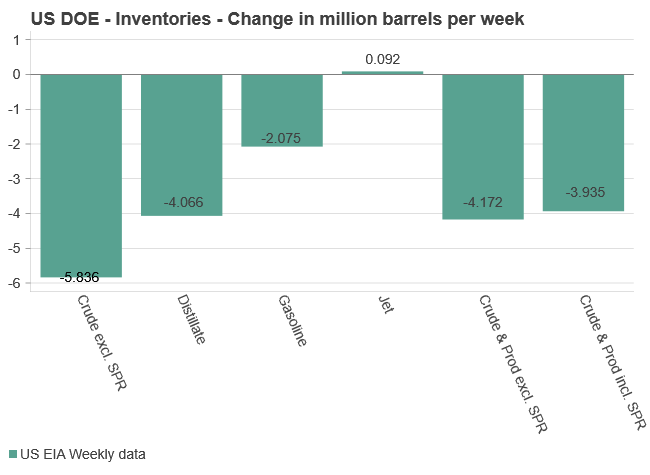
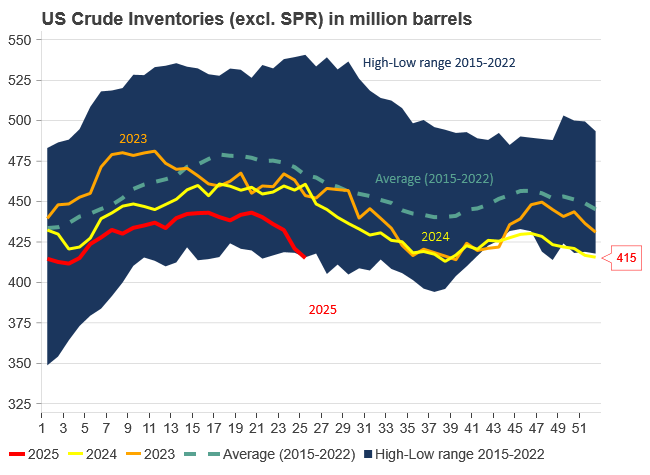
Analys
Bombs to ”ceasefire” in hours – Brent below $70

A classic case of “buy the rumor, sell the news” played out in oil markets, as Brent crude has dropped sharply – down nearly USD 10 per barrel since yesterday evening – following Iran’s retaliatory strike on a U.S. air base in Qatar. The immediate reaction was: “That was it?” The strike followed a carefully calibrated, non-escalatory playbook, avoiding direct threats to energy infrastructure or disruption of shipping through the Strait of Hormuz – thus calming worst-case fears.

After Monday morning’s sharp spike to USD 81.4 per barrel, triggered by the U.S. bombing of Iranian nuclear facilities, oil prices drifted sideways in anticipation of a potential Iranian response. That response came with advance warning and caused limited physical damage. Early this morning, both the U.S. President and Iranian state media announced a ceasefire, effectively placing a lid on the immediate conflict risk – at least for now.
As a result, Brent crude has now fallen by a total of USD 12 from Monday’s peak, currently trading around USD 69 per barrel.
Looking beyond geopolitics, the market will now shift its focus to the upcoming OPEC+ meeting in early July. Saudi Arabia’s decision to increase output earlier this year – despite falling prices – has drawn renewed attention considering recent developments. Some suggest this was a response to U.S. pressure to offset potential Iranian supply losses.
However, consensus is that the move was driven more by internal OPEC+ dynamics. After years of curbing production to support prices, Riyadh had grown frustrated with quota-busting by several members (notably Kazakhstan). With Saudi Arabia cutting up to 2 million barrels per day – roughly 2% of global supply – returns were diminishing, and the risk of losing market share was rising. The production increase is widely seen as an effort to reassert leadership and restore discipline within the group.
That said, the FT recently stated that, the Saudis remain wary of past missteps. In 2018, Riyadh ramped up output at Trump’s request ahead of Iran sanctions, only to see prices collapse when the U.S. granted broad waivers – triggering oversupply. Officials have reportedly made it clear they don’t intend to repeat that mistake.
The recent visit by President Trump to Saudi Arabia, which included agreements on AI, defense, and nuclear cooperation, suggests a broader strategic alignment. This has fueled speculation about a quiet “pump-for-politics” deal behind recent production moves.
Looking ahead, oil prices have now retraced the entire rally sparked by the June 13 Israel–Iran escalation. This retreat provides more political and policy space for both the U.S. and Saudi Arabia. Specifically, it makes it easier for Riyadh to scale back its three recent production hikes of 411,000 barrels each, potentially returning to more moderate increases of 137,000 barrels for August and September.
In short: with no major loss of Iranian supply to the market, OPEC+ – led by Saudi Arabia – no longer needs to compensate for a disruption that hasn’t materialized, especially not to please the U.S. at the cost of its own market strategy. As the Saudis themselves have signaled, they are unlikely to repeat previous mistakes.
Conclusion: With Brent now in the high USD 60s, buying oil looks fundamentally justified. The geopolitical premium has deflated, but tensions between Israel and Iran remain unresolved – and the risk of missteps and renewed escalation still lingers. In fact, even this morning, reports have emerged of renewed missile fire despite the declared “truce.” The path forward may be calmer – but it is far from stable.
Analys
A muted price reaction. Market looks relaxed, but it is still on edge waiting for what Iran will do

Brent crossed the 80-line this morning but quickly fell back assigning limited probability for Iran choosing to close the Strait of Hormuz. Brent traded in a range of USD 70.56 – 79.04/b last week as the market fluctuated between ”Iran wants a deal” and ”US is about to attack Iran”. At the end of the week though, Donald Trump managed to convince markets (and probably also Iran) that he would make a decision within two weeks. I.e. no imminent attack. Previously when when he has talked about ”making a decision within two weeks” he has often ended up doing nothing in the end. The oil market relaxed as a result and the week ended at USD 77.01/b which is just USD 6/b above the year to date average of USD 71/b.

Brent jumped to USD 81.4/b this morning, the highest since mid-January, but then quickly fell back to a current price of USD 78.2/b which is only up 1.5% versus the close on Friday. As such the market is pricing a fairly low probability that Iran will actually close the Strait of Hormuz. Probably because it will hurt Iranian oil exports as well as the global oil market.
It was however all smoke and mirrors. Deception. The US attacked Iran on Saturday. The attack involved 125 warplanes, submarines and surface warships and 14 bunker buster bombs were dropped on Iranian nuclear sites including Fordow, Natanz and Isfahan. In response the Iranian Parliament voted in support of closing the Strait of Hormuz where some 17 mb of crude and products is transported to the global market every day plus significant volumes of LNG. This is however merely an advise to the Supreme leader Ayatollah Ali Khamenei and the Supreme National Security Council which sits with the final and actual decision.
No supply of oil is lost yet. It is about the risk of Iran closing the Strait of Hormuz or not. So far not a single drop of oil supply has been lost to the global market. The price at the moment is all about the assessed risk of loss of supply. Will Iran choose to choke of the Strait of Hormuz or not? That is the big question. It would be painful for US consumers, for Donald Trump’s voter base, for the global economy but also for Iran and its population which relies on oil exports and income from selling oil out of that Strait as well. As such it is not a no-brainer choice for Iran to close the Strait for oil exports. And looking at the il price this morning it is clear that the oil market doesn’t assign a very high probability of it happening. It is however probably well within the capability of Iran to close the Strait off with rockets, mines, air-drones and possibly sea-drones. Just look at how Ukraine has been able to control and damage the Russian Black Sea fleet.
What to do about the highly enriched uranium which has gone missing? While the US and Israel can celebrate their destruction of Iranian nuclear facilities they are also scratching their heads over what to do with the lost Iranian nuclear material. Iran had 408 kg of highly enriched uranium (IAEA). Almost weapons grade. Enough for some 10 nuclear warheads. It seems to have been transported out of Fordow before the attack this weekend.
The market is still on edge. USD 80-something/b seems sensible while we wait. The oil market reaction to this weekend’s events is very muted so far. The market is still on edge awaiting what Iran will do. Because Iran will do something. But what and when? An oil price of 80-something seems like a sensible level until something do happen.
-

 Nyheter4 veckor sedan
Nyheter4 veckor sedanStor uppsida i Lappland Guldprospekterings aktie enligt analys
-

 Nyheter4 veckor sedan
Nyheter4 veckor sedanSilverpriset släpar efter guldets utveckling, har mer uppsida
-
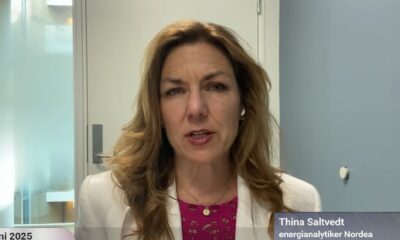
 Nyheter3 veckor sedan
Nyheter3 veckor sedanUppgången i oljepriset planade ut under helgen
-

 Nyheter3 veckor sedan
Nyheter3 veckor sedanLåga elpriser i sommar – men mellersta Sverige får en ökning
-

 Nyheter2 veckor sedan
Nyheter2 veckor sedanMahvie Minerals växlar spår – satsar fullt ut på guld
-

 Analys3 veckor sedan
Analys3 veckor sedanVery relaxed at USD 75/b. Risk barometer will likely fluctuate to higher levels with Brent into the 80ies or higher coming 2-3 weeks
-

 Nyheter1 vecka sedan
Nyheter1 vecka sedanOljan, guldet och marknadens oroande tystnad
-

 Nyheter1 vecka sedan
Nyheter1 vecka sedanJonas Lindvall är tillbaka med ett nytt oljebolag, Perthro, som ska börsnoteras




